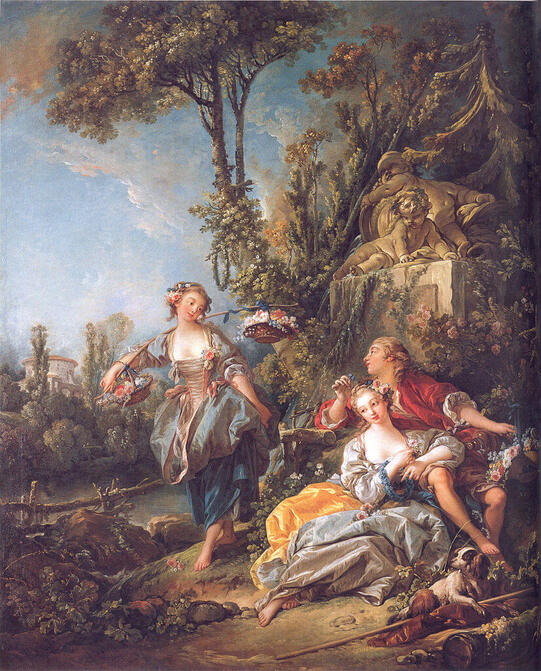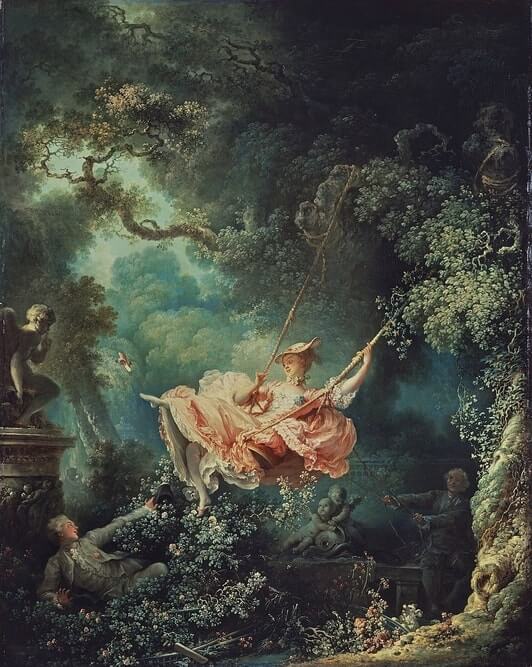|
Where? The French Gallery of the Timken Museum of Art
When? 1758 What do you see? Two lovers rest by a trail in a blooming garden. Their clothes are disheveled and unbuttoned. With one hand, the young man puts flowers into his lover’s hair. In the other hand, he holds her hat, filled with pastel-colored blooms. Resting her arm on his knee, the young lady holds a wreath of blue flowers on her arm. As she looks off to her right, she doesn’t seem to notice the shepherdess entering on the left side of the painting. This woman wears less lavish clothes than the couple, and she carries two baskets of flowers. She tilts her head as the young man flirts with her in an act of playful infidelity. And the young man’s lover doesn’t seem to mind. On the bottom right is a spaniel, which either is the dog of the couple or an ironic symbol of loyalty. Above the scene is a statue of two babies playing and watching the scene unfold. Backstory: Boucher probably created this painting to decorate the salon of an aristocrat’s country house. Focusing on the theme of love, Boucher sets the intimate and dreamy scene in a beautiful garden. Like most Rococo paintings, the colors and textures of the painting are delicate, soft, and feminine. Besides romance and coquetry, this painting also shows a romanticization of the peasantry in France during this time. Many aristocrats of this time fantasized about life in the country, working as a farmer or milkmaid. The inclusion of the young shepherdess in this painting may be a nod to this trend. While very beautiful, rococo paintings like Lovers in a Park, were often criticized for their artificiality and unrealistic subject matter. Who is François Boucher? François Boucher was born in Paris in 1703 where he would die in 1770. His father was a decorator who specialized in embroidery. Boucher studied under François Lemoyne and later under François Cars, an esteemed engraver. During this time, Boucher engraved many of Watteau’s drawings and became familiar with his style very quickly. In 1723, Boucher was awarded first place in the Academy competition. Afterwards, he traveled to Italy where he studied with Carle Vanloo. Though his style was not heavily influenced by this trip, when he returned to Paris, he became fascinated with fashion and sought to depict it in his works. After being admitted to the French Academy in 1734 for his work, Rinaldo and Armida, Boucher caught the attention of Madame Pompadour who essentially made him her personal painter. It was around this time that Boucher took a young Jean-Honoré Fragonard on as a student. In 1755, Boucher began working on tapestries for the Gobelins tapestry works, producing pieces for operas and festivals. In 1765, he became the director of the French Academy and Madame Pompadour appointed him First Painter to the King.
Fun fact: A leisure activity for many aristocrats of this time was to dress up in simpler clothes made out of cheaper materials and role play the idealized life of a peasant. The clothes they wore, though plainer than their usual outfits, would be higher quality than what peasants actually wore. The young shepherdess in Lovers in a Park wears clothing in this style.
Written by Sabrina Tian
References:
0 Comments
Leave a Reply. |
Categories
All
|
- Home
- Blog
-
Museums
- Alte Pinakothek
- Art Institute of Chicago
- Baltimore Museum of Art
- Barber Institute of Fine Arts
- Bargello
- Barnes Foundation
- British Museum
- Church of Sant’Anastasia
- Cleveland Museum of Art
- Courtauld Institute of Art
- Detroit Institute of Arts
- Frans Hals Museum
- Galleria Borghese
- Gallerie dell'Accademia
- Getty Museum
- Guggenheim
- Hermitage Museum
- Kunsthistorisches Museum
- Kunstmuseum Basel
- Legion of Honor Museum
- Louvre
- Mauritshuis
- Metropolitan Museum of Art
- Musee d’Orsay
- Museum of Fine Arts in Boston
- Museum of Modern Art
- National Gallery in London
- National Gallery of Art
- National Museum in Poznań
- Norton Simon Museum
- Ny Carlsberg Glyptotek
- Palace of Versailles
- Palazzo Pitti
- Palazzo Vecchio
- Petit Palais
- Philadelphia Museum of Art
- Prado
- Pushkin Museum
- Ravenna Art Museum
- Rijksmuseum
- San Diego Museum of Art
- Santa Maria delle Grazie
- St. Peter's Basilica
- Städel Museum
- Statens Museum for Kunst
- Tate Britain
- Tate Modern
- Timken Museum of Art
- Uffizi
- Vatican Museums
- Wallace Collection
-
Artists
- Altdorfer
- Anguissola
- Berlin Painter
- Bosch
- Botticelli
- Boucher
- Bronzino
- Bruegel the Elder
- Brunelleschi
- Cabanel
- Caillebotte
- Canova
- Caravaggio
- Carpeaux
- Cezanne
- Cimabue
- David
- Degas
- Delacroix
- De Maria
- Donatello
- El Greco
- Fontana
- Fra Angelico
- Fragonard
- Gauguin
- Gentileschi
- Gericault
- Gonzalez-Torres
- Goya
- Hals
- Hogarth
- Hokusai
- Ingres
- Leonardo da Vinci
- Lippi, Filippo
- Longhi, Barbara
- Lorrain
- Makovsky
- Manet
- Massys
- Matisse
- Merian
- Michelangelo
- Mochi
- Modigliani
- Monet
- Panini
- Parmigianino
- Perugino
- Picasso
- Pisanello
- Raphael
- Rembrandt
- Renoir
- Reynolds
- Rivera
- Rodin
- Rubens
- Scultori
- Seurat
- Steen
- Tintoretto
- Titian
- Toulouse-Lautrec
- Turner
- Uccello
- Van der Weyden
- Van Dyck
- Van Eyck
- Van Gogh
- Van Hemessen
- Vasari
- Velazquez
- Vermeer
- Veronese
- Vigée Le Brun
-
Locations
- Books
- About Us



